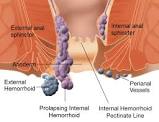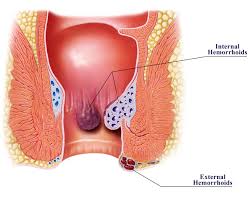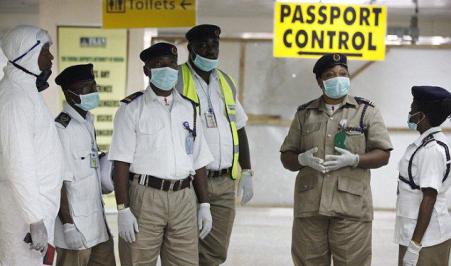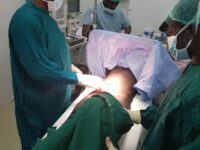 Piles are hemorrhoids that become inflamed. Hemorrhoids are masses, clumps, cushions of tissue in the anal canal – they are full of blood vessels, support tissue, muscle and elastic fibers.
Piles are hemorrhoids that become inflamed. Hemorrhoids are masses, clumps, cushions of tissue in the anal canal – they are full of blood vessels, support tissue, muscle and elastic fibers.
Although hemorrhoids are thought of as unpleasant inflammations, we all have them.1 It is when the hemorrhoidal cushions become too big (inflamed) that problems occur – when this happens they are called piles or pathological hemorrhoids.2
What are piles?
Piles can be of various sizes and may be internal (inside the anus) or external ones (outside the anus). Typically, internal piles occur from 2 to 4cm above the opening of the anus. External piles (perianal hematoma) occur on the outside edge of the anus. The internal ones are much more common.3
According to the US National Institutes of Health (NIH), symptomatic hemorrhoids affect at least half the American  population at some time in their lives before the age of 50.4
population at some time in their lives before the age of 50.4
In the majority of cases, piles are effectively treated with over-the-counter medications, a good fluid intake, and by following a diet high in fiber. In severe cases, the piles may have to be surgically removed. About 10% of patients who go and see their doctor about piles eventually require surgical intervention.2
Symptoms of piles
In most cases piles are not serious and go away on their own after a few days.5
An individual with piles may experience the following symptoms:
A hard lump may be felt around the anus. It consists of coagulated blood, called a thrombosed external hemorrhoid. This can be painful
After going to the toilet, a feeling that the bowels are still full
Bright red blood after a bowel movement
Itchiness around the anus
Mucus discharge when emptying the bowels
Pain while defecating
The area around the anus may be red and sore.
Internal hemorrhoids are classified into four grades:
Grade 1 – there are small inflammations, usually inside the lining of the anus. They are not visible
Grade 2 – larger than grade 1 hemorrhoids, but also inside the anus. When passing a stool, they may get pushed out, but return unaided
Grade 3 – often called ‘prolapsed hemorrhoids’; these appear outside the anus. The patient may feel them hanging out. They can be pushed back in if the patient presses with their finger
Grade 4 – these cannot be pushed back in and need to be treated by a doctor. They are large and stay outside the anus all the time.
External hemorrhoids are called perianal hematoma. These are small lumps that are located on the outside edge of the anus. They are very itchy and can be painful if a blood clot forms inside (thrombosed external hemorrhoid). Thrombosed external hemorrhoid requires medical treatment straight away.
Why do piles occur?
The blood vessels around the anus and in the rectum will stretch under pressure and may swell or bulge. Inflamed veins (hemorrhoids) can develop when pressure increases in the lower rectum. This may be due to:
Chronic constipation
Chronic diarrhea
Lifting heavy weights
Pregnancy
Straining when passing a stool.
The tendency to develop hemorrhoids may also be inherited. The risk of developing piles grows with age.
Diagnosing piles
A doctor can usually diagnose piles after carrying out a physical examination, examining the patient’s anus.
The doctor may ask the following questions:
Do any close relatives (parents, siblings) have piles?
Has there been any blood on the stools?
Has there been any mucus on the stools?
Has there been any recent weight loss?
Have bowel movements changed recently?
What color are the stools?
For internal hemorrhoids, the doctor may perform a digital rectal examination (DRE) or use a proctoscope – a hollow tube fitted with a light. The proctoscope allows the doctor to see the anal canal and take a small tissue sample from inside the rectum, which can be sent to the lab for analysis.
If the physician is presented with signs and symptoms which may suggest another digestive system disease, risk factors for colorectal cancer, and some other factors, he/she may recommend ordering an examination of the colon using colonoscopy.
Treatments for piles
In the majority of cases, piles resolve on their own without the need for any treatment. Treatments can help significantly reduce the discomfort and itching that many patients experience.
A good doctor will initially recommend some lifestyle changes.
Diet – piles can be caused by too much straining when doing bowel movements, which is the result of constipation. A change in diet can help keep the stools regular and soft. This involves eating more fiber, such as fruit and vegetables, or switching your cereal breakfast to bran.
Water is the best drink, and the patient may be advised to increase his/her water consumption. Some experts say too much caffeine is not good.
Body weight – if the patient is obese, losing weight may help reduce the incidence and severity of hemorrhoids.
Simple things you can do yourself to help prevent piles:10
Try not to strain when you go to the toilet
Avoid laxatives
Exercise.
Ointments, creams, pads and other OTC medications – there are some over-the-counter (OTC) medications which help soothe the redness and swelling around the anus area. Some of them contain witch hazel, hydrocortisone, or some other active ingredient which can relieve symptoms of itching and pain.1813
It is important to remember that they do not cure piles, they only treat the symptoms. Do not use them for more than seven consecutive days – longer periods may irritate the anus area and cause skin thinning. Unless advised to by your doctor, do not use two or more medications simultaneously.
Corticosteroids – these can reduce inflammation and pain.13
Painkillers – ask your pharmacist for suitable painkilling medications, such as acetaminophen (Tylenol).19
Laxatives – the doctor may prescribe one if the patient suffers from constipation.19
Banding – the doctor places an elastic band around the base of the pile inside the anus, cutting off its blood supply. After a few days the hemorrhoids fall off. This can work for grades 2 and 3 hemorrhoids.19
Sclerotherapy – a medicine is injected to make the hemorrhoid shrink – the hemorrhoid eventually shrivels up. This is effective for grades 2 and 3 hemorrhoids, and is a useful alternative to banding.19
Infrared coagulation – also referred to as infrared light coagulation. Used for grades 1 or 2 hemorrhoids. A device burns the hemorrhoid tissue.
Surgery – used for particularly large piles, or grades 3 or 4 hemorrhoids. Generally, surgery is used if other procedures were not effective. Sometimes surgery is done on an outpatient basis – the patient goes home after the procedure.
Hemorrhoidectomy – the excess tissue that is causing the bleeding is surgically removed. This can be done in various ways. It may involve a combination of a local anesthetic and sedation, a spinal anesthetic, or a general anesthetic. This type of surgery is the most effective in completely removing piles, but there is a risk of complications, which can include difficulties passing stools, as well as urinary tract infections.
Hemorrhoid stapling – blood flow is blocked to the tissue of the hemorrhoid. This procedure is usually less painful than hemorrhoidectomy. However, there is a greater risk of hemorrhoid recurrence and rectal prolapse (part of the rectum pushes out of the anus).
Complications linked to piles
Anemia – hemorrhoids can sometimes cause long-term blood loss, which may lead to anemia.
Stangulated hemorrhoid – the blood supply to an internal hemorrhoid is cut off, causing severe pain, and even gangrene (death of tissue).






So with this plenty talk on piles, do your center have a cure for it without not going through surgery?
Please call 024 9 57 96 64